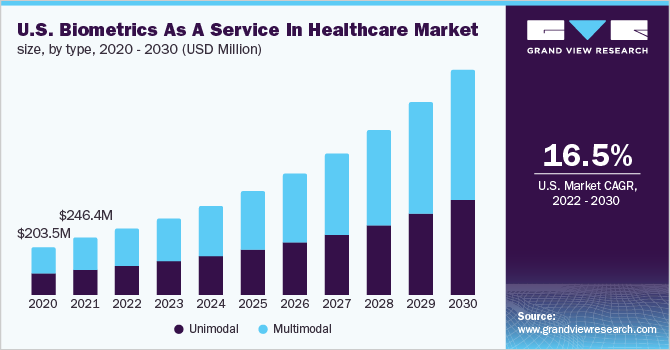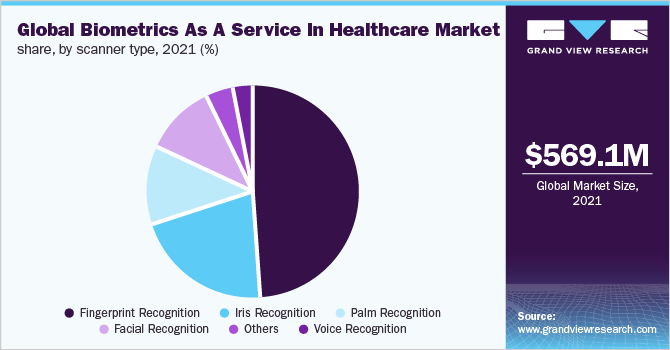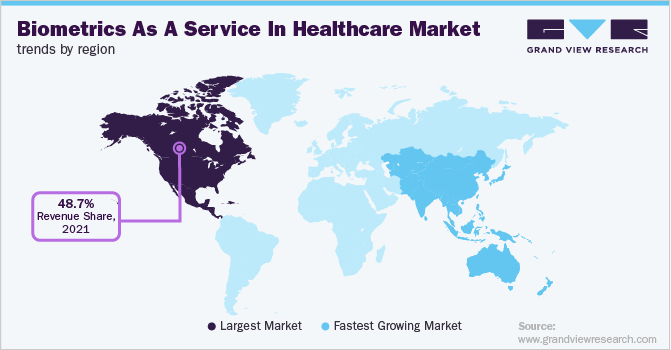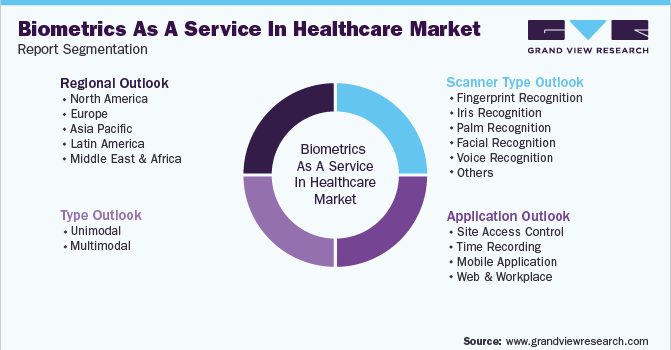- Home
- »
- Healthcare IT
- »
-
Biometrics As A Service In Healthcare Market Size Report, 2030GVR Report cover
![Biometrics As A Service In Healthcare Market Size, Share & Trends Report]()
Biometrics As A Service In Healthcare Market Size, Share & Trends Analysis Report By Type (Unimodal, Multimodal), By Application (Site Access Control, Time Recording), By Scanner Type, By Region, And Segment Forecasts, 2022 - 2030
- Report ID: GVR-4-68040-001-9
- Number of Report Pages: 90
- Format: PDF, Horizon Databook
- Historical Range: 2017 - 2020
- Forecast Period: 2022 - 2030
- Industry: Healthcare
Report Overview
The global biometrics as a service in healthcare market size was estimated at USD 569.1 million in 2021 and is expected to expand at a compound annual growth rate (CAGR) of 17.6% from 2022 to 2030. The major factor driving biometrics as a service in the healthcare market include increased usage of mobile devices, expanding user numbers and government data-security measures, and the rising need for effective fraud detection & prevention solutions in the healthcare sector. Furthermore, the increasing integration of blockchain and AI technologies with Biometrics-as-a-Service (BaaS) solutions would provide opportunities for biometrics-as-a-service suppliers.

COVID-19 had a positive impact on the market. Biometrics, artificial intelligence (AI), and machine learning played an important role in reacting to the pandemic. Biometric systems were integrated and adopted around the world as critical tools for COVID-19 early detection, medical screening, and public safety monitoring. Biometrics were integrated into infectious disease prevention and control procedures in key areas such as law enforcement, surveillance, healthcare, border control, and biotechnologies.
Touchless biometric identification technologies such as face recognition and iris recognition, according to industry analysts, are projected to acquire significant popularity during the COVID-19 pandemic. To combat the spread of COVID-19, law enforcement agencies, some governments, and other organizations shifted from touch-based biometric authentication to touchless biometric authentication solutions. As a result, Al and ML technologies and algorithms stretched to their boundaries to develop and improve cutting-edge contactless biometrics identification methods.
Increasing adoption of biometrics due to its cost-effectiveness, ability to easily integrate cloud technology with healthcare services, and high-end assurance and security are some of the factors fueling the growth of the market. Many healthcare organizations have shifted from the traditional paper-based record management system to cloud-based biometrics management. Additionally, the technological developments in cloud infrastructure have enabled this shift and have resulted in a significant boost in the market.
Biometrics is an identification technology that is used to recognize individuals by their physical traits such as fingerprints, face, iris, voice, and palm vein. Biometric recognition is applied in the healthcare industry to avoid financial losses caused by medical identity fraud. The application of biometrics in healthcare started with unimodal biometric systems which were later replaced by multi-modal biometric systems which are more accurate and precise. In recent years, biometric technology has advanced, and the development of Biometrics-as-a-service has taken priority over on-premises biometric deployments.
Healthcare professionals manage a wide range of individual data, from delicate health information, insurance, and financial data, and other personal identification information such as social security numbers and addresses. That is one of the reasons healthcare information is held under the severe administrative standards of the Healthcare Insurance Portability and Accountability Act (HIPAA) and other administrations. Accordingly, it is essential to secure this information and guarantee that the healthcare experts are sharing or discussing that information with the right individual. Biometrics as a service in healthcare is used for large-scale biometrics deduplication and verification and helps healthcare IT teams optimize and configure the system to complement various healthcare applications.
Advanced technological developments in IoT and AI have also helped in the growth of cloud-based biometrics. Many healthcare organizations have become increasingly conscious of the focus on surveillance and security of medical patient information which has increased the demand for BaaS. Although, in developing countries, the market has not penetrated as deeply due to the lack of technological expertise, cloud infrastructure, strong network connections, and a skilled workforce. BaaS solutions have high initial investments, and privacy and security concerns regarding the biometric data stored on the cloud have hindered market growth to some extent.
Type Insights
Based on type, the market is segmented into unimodal and multimodal. The multimodal segment dominated the market with the largest market share of 54.9% in 2021, as multimodal biometric systems reduce data distortion, it is cost-effective and more accurate than unimodal ones. The demand for multimodal systems is increasing as multimodal biometric systems are extremely difficult to replicate. Even if one biometric identification is compromised, the individual can be authenticated using the other biometric identifier.
The multimodal segment is also expected to witness the fastest growth with a CAGR of 18.2% during the forecast period. Multimodal biometrics has a significantly greater verification rate as compared to unimodal biometrics and hence is more popular among healthcare organizations. Multimodal biometrics uses a combination of two identification traits, for example, fingerprint and face or fingerprint and iris. This increases the accuracy and performance of the identification process.
Application Insights
Based on application, the mobile application segment held the dominant share of over 41.1% in 2021 and is also expected to witness the fastest growth during the forecast period with a CAGR of 19.2% from 2022 to 2030. The rising need for appropriate authentication techniques in mobiles is driving the mobile application segment in the market. Additionally, the increasing frequency of cyber-attacks is also expected to the expansion of the mobile biometric business.
The industrial convergence on developing biometric intelligence in mobile devices is driving the mobile application segment various companies have launched biometrics-enabled phones in the past few years. Moreover, government initiatives for biometric adoption, the introduction of e-passports, an increase in mobile transactions, and a growing number of smartphone suppliers choosing biometric capabilities are factors fueling the growth of the segment.
Scanner Type Insights
Based on scanner type, the market is segmented into fingerprint recognition, iris recognition, palm recognition, facial recognition, voice recognition, and others. The fingerprint recognition segment held the largest market share of 49.4% in 2021. The need for a highly accurate and dependable technique for securing important healthcare information and preventing mistakes that might mean the difference between life and death is driving the segment's growth. Fingerprints are the most accurate method of identification, as every individual has distinct sets of fingerprints. Fingerprint biometrics assists hospitals in meeting government rules such as the Health Insurance Portability and Accountability Act (HIPAA) and other legislation across the world that require the protection of patient privacy.

The facial recognition segment is expected to witness the fastest growth during the forecast period with a CAGR of 20.9% from 2022 to 2030. The demand for the segment is expected to increase in coming years as no physical contact is necessary, unlike fingerprint or other security methods, facial recognition provides an automated, rapid, and seamless verification experience. Favorable government initiatives are projected to have a positive impact on the segment's growth. Furthermore, facial recognition offers various applications in healthcare including attendance tracking, Patient check and check out, access control, Patient monitoring and diagnosis, security and surveillance, and Caretaking robots
Regional Insights
In 2021, North America dominated the market in terms of the revenue share of 48.7% owing to the growing adoption of biometrics as a service in healthcare across various verticals within the healthcare industry. Moreover, increased demand during COVID-19 accelerated the growth of the market. Furthermore, the increasing implementation of biometrics in different sectors such as homeland security, law, and military, among others, is driving market expansion in the U.S. Large-scale financed initiatives and staff access monitoring in buildings are driving revenue development in this region. Rapid development in online transactions, an increase in complex cyber-attacks, and high IT security spending are all important reasons driving this region's BaaS industry. In addition, the adoption of sophisticated biometrics in different IoT-based devices in this area has increased the demand for biometrics-as-a-service.

Asia Pacific is projected to witness a promising growth rate during the forecast period with a CAGR of 19.0% from 2022 to 2030. Increased terror risks and rising government expenditure on security are two main drivers driving access control solution sales in the Asia Pacific region. Furthermore, China's expanding economy produces a large need for security solutions. The development of the market in the APAC region is fueled by increasing cyber-attacks, as well as the difficulty of big and small enterprises in this region to manage and mitigate the risks connected with identity-related intrusions. A rise in government investments in biometric initiatives such as national ID cards and e-passports, as well as the development of smart cities and connected devices, are likely to impact the growth of the Asia-Pacific biometrics-as-a-service market.
Key Companies & Market Share Insights
Rapid developments in technology and the increasing adoption of biometrics as a service in the healthcare market paired with the rising cybercrime threats targeting the healthcare industry are estimated to be the driving factors of the market. The need for technological innovations due to the change in trends in healthcare services with services such as know your patient, remote patient access, anywhere care, and patient monitoring has led to the increased adoption of biometrics as a service in healthcare.
The increasing number of players in the market is also one of the factors driving the market owing to the high competition with leads to innovations and product launches. In September 2018, ARA (Afya Research Africa), a Kenyan healthcare provider, announced that they have started utilizing fingerprint biometrics by Integrated Biometrics to identify the provision of medical care to people in regions without technological infrastructure while maintaining their privacy. Some of the prominent players operating in global biometrics as a service in the healthcare market include:
-
Thales
-
Fujitsu
-
Aware, Inc.
-
BIO-key International
-
MorphoTrust USA
-
NextGate, Imprivata, Inc.
-
Suprema
-
Imageware
-
M2SYS Technology
Biometrics As A Service In Healthcare Market Report Scope
Report Attribute
Details
Market size value in 2022
USD 0.66 billion
Revenue forecast in 2030
USD 2.43 billion
Growth rate
CAGR of 17.6% from 2022 to 2030
Base year for estimation
2021
Historical data
2017 - 2020
Forecast period
2022 - 2030
Quantitative units
Revenue in USD million and CAGR from 2022 to 2030
Report coverage
Revenue forecast, company share, competitive landscape, growth factors & trends
Segments covered
Type, application, scanner type, region
Regional scope
North America; Europe; Asia Pacific; Latin America; MEA
Country scope
U.S.; Canada; U.K.; Germany; France; Italy; Spain; Russia; Japan; China; India; Australia; South Korea; Singapore; Brazil; Mexico; Argentina; South Africa; UAE; Isreal
Key companies profiled
Thales,Fujitsu,Aware, Inc.,BIO-key International,MorphoTrust USA,NextGate, Imprivata, Inc.,Suprema,Imageware,M2SYS Technology
Customization scope
Free report customization (equivalent up to 8 analyst’s working days) with purchase. Addition or alteration to country, regional & segment scope.
Pricing and purchase options
Avail customized purchase options to meet your exact research needs. Explore purchase options
Global Biometrics As A Service In Healthcare Market Segmentation
This report forecasts revenue growth and provides an analysis of the latest trends in each of the sub-segments from 2017 to 2030. For this study, Grand View Research has segmented global biometrics as a service in the healthcare market report based on type, application, scanner type, and region:

-
Type Outlook (Revenue, USD Million, 2017 - 2030)
-
Unimodal
-
Multimodal
-
-
Application Outlook (Revenue, USD Million, 2017 - 2030)
-
Site Access Control
-
Time Recording
-
Mobile Application
-
Web and Workplace
-
-
Scanner Type Outlook (Revenue, USD Million, 2017 - 2030)
-
Fingerprint Recognition
-
Iris Recognition
-
Palm Recognition
-
Facial Recognition
-
Voice Recognition
-
Others
-
-
Regional Outlook (Revenue,USD Million, 2017 - 2030)
-
North America
-
U.S.
-
Canada
-
-
Europe
-
U.K.
-
Germany
-
France
-
Italy
-
Spain
-
Russia
-
-
Asia Pacific
-
Japan
-
China
-
India
-
Australia
-
South Korea
-
Singapore
-
-
Latin America
-
Brazil
-
Mexico
-
Argentina
-
-
Middle East & Africa
-
South Africa
-
Saudi Arabia
-
UAE
-
Isreal
-
-
Frequently Asked Questions About This Report
b. The global biometrics as a service in healthcare market size was estimated at USD 569.1 million in 2021 and is expected to reach USD 0.66 billion in 2022.
b. The global biometrics as a service in healthcare market is expected to grow at a compound annual growth rate of 17.6% from 2022 to 2030 to reach USD 2.43 billion by 2030.
b. In 2021, North America dominated the market in terms of revenue share of 48.7% owing to the growing adoption of biometrics as a service across various verticals within the healthcare industry. Moreover, increased demand during COVID-19 accelerated the growth of the market.
b. Some of the key market players operating in the biometrics as a service market are Thales, Fujitsu, Aware, Inc., BIO-key International, MorphoTrust USA, NextGate, Imprivata, Inc., Suprema, Imageware, and M2SYS Technology, among others.
b. The major factor driving the biometric-as-a-service in the healthcare market include increased usage of mobile devices, expanding user numbers and government data-security measures, and the rising need for effective fraud detection & prevention solutions in the healthcare sector. Furthermore, the increasing integration of blockchain and AI technologies with Biometrics-as-a-Service (BaaS) solutions would provide opportunities for BaaS suppliers.
Share this report with your colleague or friend.
![gvr icn]()
NEED A CUSTOM REPORT?
We can customize every report - free of charge - including purchasing stand-alone sections or country-level reports, as well as offer affordable discounts for start-ups & universities. Contact us now
![Certified Icon]()
We are GDPR and CCPA compliant! Your transaction & personal information is safe and secure. For more details, please read our privacy policy.
We are committed towards customer satisfaction, and quality service.
"The quality of research they have done for us has been excellent."





